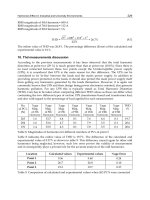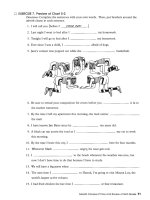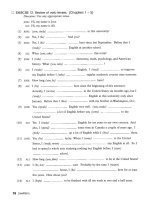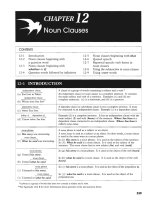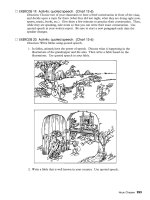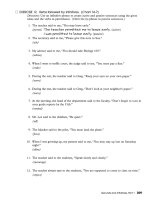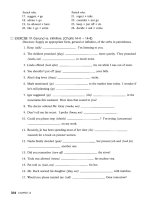Understanding And Applying Machine Vision Part 13 ppsx
Bạn đang xem bản rút gọn của tài liệu. Xem và tải ngay bản đầy đủ của tài liệu tại đây (179.11 KB, 25 trang )
Tessellation
Pixel pattern. Most tesselations are square (square pixels); some are rectangular (rectangular pixels).
Texture
Local variation in pixel values that repeats in a regular or random way across a portion of an image or object. Texture
is concerned with the spatial distribution of the gray shades and discrete tonal features. When a small area of the image
has little variation of discrete tonal features, the dominant property of that area is gray shade. When a small area has
wide variation of discrete tonal features, the dominant property of that area is texture. There are three things crucial in
this distinction: (1) the size of the small areas, (2) the relative sizes of the discrete tonal features, and (3) the number of
distinguishable discrete tonal features.
Texture Gradient
Refers to the increasing fineness of visual texture with depth observed when viewing a two-dimensional image of a
three-dimensional scene containing approximately uniform textured surfaces.
Three-Dimensional Analysis
Type of vision algorithm that develops a three-dimensional model of a part and matches it to stored models.
Page 378
Threshold
Intensity (specific pixel value) below which a stimulus produces no effect or response. Dynamic threshold: When
threshold result depends on the location of a pixel, the characteristic pixel value and some local property. Global
threshold: When threshold result depends only on comparison of a pixel value with a global constant (a single
brightness value, a single color value, etc.). Local threshold: When threshold result depends on comparison of a joint
local property and a characteristic pixel value with a single decision value, e.g., Threshold is based on comparing the
difference between pixel value and neighborhood value with a global value.
Thresholding
Scene segmentation process based on converting a gray scale image into a binary image by reassigning pixel gray
levels to only two values. Regions of an image are separated based on pixel values above and below a chosen intensity
level.
Threshold Value
Decision point above or below which a decision is made, e.g., a pass or fail point.
Throughput Rate
Generally refers to the number of objects to be examined per unit of time.
Time of Flight
Technique of inferring shape from reflection of active light signal off object based on measuring elapsed time for
signal to return when an impulse source is used or by modulating a CW source signal and matching the return signal to
measure phase differences that are in turn interpreted as range measurements.
Token
In a data flow machine, term associated with combination of data word and label or tag.
Tolerance
Amount that establishes the range upon which to base the differentiation between good and bad products.
Top-Down Approach
Goal-directed image analysis approach in which the interpretation stage is guided in its analysis by trial or test
descriptions of a scene. Sometimes referred to as "hypothesize and test."
Tracking
Processing sequences of images in real time to derive a description of the motion of one or more objects in a scene.
Transforms
Various mathematical transformations applied to image data for the purpose of analysis. See Image Transformation.
Transition
In a binary image, the point where the pixels change between light and dark.
Transition Counting
Modeling of a scene based on the number of white-to black and black-to-white pixel changes.
Translation
Movement left or right, up or down, but not rotated; geometric operation that shifts the position of an image from its
original position.
Transmission
Passage of light or other signal.
Transmittance, Transmittance Coefficient
Ratio of the energy per unit time per unit area (radiant power density) transmitted through the object to the energy per
unit time per unit area incident on the object. In general, transmittance
Page 379
is a function of the incident angle of the energy, viewing angle of the sensor, spectral wavelength and bandwidth, and
the nature of the object.
Tree
Hierarchical representation of a scene.
Triangulation
Method of determining distance by trigonometry.
Two and One-Half Dimensions (2 1/2 D)
Photometric stereo; see Needle Diagram.
U
Ultraviolet (UV)
Region of the electromagnetic spectrum adjacent to the visible portion of the spectrum but with wavelengths between
100 and 400 nanometers.
Union (of Two Images)
Logical operation forming a new image that is black at all points where either of the two images are black.
V
Vector Encoding
Method of characterizing line segments extracted from a scene, specifying each segment as a pair of image coordinates
corresponding to the segment's end points.
Verification
Activity providing qualitative assurance that a fabrication or assembly process was successfully completed.
Vertex
Point on a polyhedron common to three or more sides.
Vertical Resolution
Number of horizontal lines that can be seen in the reproduced image.
Vertical Sync
Circuit to retrace the scan from bottom to top.
Video
Analog time-varying output signal from an image sensor that conveys the image data.
Video Image
Image in electronic signal format capable of being displayed on a cathode-ray tube screen. The video signal is
generated from such devices as a vidicon or flying spot scanner, which convert an image from photographic form to
video signal form by scanning it line by line. The video signal itself is a sequence of signals, the signal representing the
line of the scanned image.
Vidicon
Image pickup tube in which a change density pattern is formed by photoconduction and stored on that surface of the
photoconductor that is scanned by an electron beam.
Visible
Light that can be seen by the eye. Having wavelength between 400 and 750 nanometers.
Vision
Process of understanding the environment based on sensing the light level or reflectance property of objects.
Von Neumann Architecture
Current standard computer architecture that uses sequential processing.
W
Walsh-Hadamard Transform
See Hadamard Transform.
Wavelength
Reciprocal of frequency. The distance covered by one cycle or event.
Window
Selected portion of an image. Also, a limited range of gray scale values.
Page 380
Windowing
Technique for reducing data-processing requirements by electronically defining only a small portion of the image to be
analyzed. All other parts of the image are ignored.
Wireframe Model
Three-dimensional model, similar to a wireframe, in which the object is defined in terms of edges and vertices.
Z
Zoom
To enlarge or reduce the size of an image. It may be done electronically or optically.
Zoom Lens
Optical system of continuously variable focal length, the focal plane remaining in a fixed position.
Page 381
Appendix B—
Machine Vision Application Checklist
This is a form to assist in developing ideas and requirements for machine vision applications. It contains many typical
questions to help determine feasibility, benefits and cost. Permission is granted to use this form.
Section 1—
Production Process
1. What do you make?
2. How do you make it?
3. What is the expected life of the product?
4. Is the product and the problem going to be around long enough to justify the purchase of a system?
5. Why do you need to inspect or control the process? Are there problems? Is process improvement the goal?
6. What is the current reject rate of bad parts?
7. What is the accuracy of the current inspection system?
Page 382
8. If you inspect or improve control, what are the specific benefits you expect to achieve?
9. Will the system be for a new line or an old line (retrofit)?
10. Does your application involve: one object at a time?
Multiple objects? How many different objects?
What are the different part numbers?
11. Is it a batch operation? or a continuous dedicated process/line?
12. What are the changeover times and the frequency of changeovers?
13. What are the skill levels involved in changeover?
14. How is inspection and/or function to be replaced currently being performed? Is it effective?
15. Is inspection to be: On line? or Off line?
16. Must every produced item be inspected, or can you randomly sample?
17. Will new part models or variations be added to the system at a later date? Define any potential future inspections
that may be required of the same machine vision systems:
18. Are product design or production process changes anticipated?
19. Where do parts come from?
20. Can rejected parts be repaired?
21. Can vision assist in the diagnosis?
22. Where do pass and fail parts go?
23. When is the machine vision system needed by?
24. How many shifts will the system be used?
25. How many lines/machine will the vision system be needed for?
26. What is the attitude of the plant floor people towards machine vision/automation?
27. What is the attitude of the plant's management toward machine vision/automation?
28. What is your attitude towards machine vision/automation?
29. Can a representative sample of parts be provided to system vendors or integrators for evaluation?
Page 383
30. Can drawings be provided?
31. Can video of line be provided?
32. Can the vision suppliers observe production at your facility?
Section 2—
Benefits of Inspection
1. When an incorrect or flawed part escapes detection, what are the downstream effects? (quality, repair, machine
downtime, etc.):
2. If a bad part is assembled, does it cause problems with the overall assembly?
3. If inspection is implemented, can any downstream testing requirements be relaxed?
4. If inspection is implemented, do you expect the yield through test to be improved?
5. At the inspection point, what is the cost (qualitative or quantitative) of a bad (faulty) part that escapes?
6. At the inspection point, what is the cost (qualitative or quantitative) of a good part that is falsely rejected?
Section 3—
Application
1. Describe the application:
2. What distinguishes a bad part from a good part?
3. Generically, does the application involve:
Gaging? (Show a sketch or drawing, if possible. Highlight critical items.)
What are tightest tolerances? On what specific dimension?
What is the design goal for accuracy?
What is the design goal for repeatability?
Are there features that serve as references?
Describe calibration requirements:
Page 384
Assembly Verification?
Dimensions of assembly:
Presence/absence:
Orientation:
What is the smallest piece to be verified?
What are the dimensions of that piece?
What is the largest piece to be verified?
What are the dimensions of that piece?
Do you also need to verify the correctness of the part?
Flaw inspection?
Describe flaw types:
What is the smallest size flaw?
Does the flaw affect surface geometry?
Does the flaw affect surface reflectivity?
Is it more of a stain?
Is classification of flaws required?
Location analysis?
What is the design goal for accuracy?
What is the design goal for repeatability?
What is the area over which "find" is required?
Describe calibration requirements:
Pattern recognition?
What is the size of the pattern?
Describe the differences between patterns:
Is there a background pattern?
Color?
Geometric?
Number of different patterns?
Purpose: to identify? to sort? other?
Page 385
Are pattern differences geometric?
Are pattern differences photometric?
Are pattern differences color?
Is application specifically OCR? OCV
Handwritten characters? Fixed font? Variable font?
What is the height of the characters?
What is the stroke width?
What is the spacing between characters?
What is the spacing around the characters?
How many characters in a string?
How many lines?
Describe background
What is the color of the characters?
What is the color of the background?
Section 4—
Part to Be Inspected
1. Describe the part(s) to be inspected (consider those conditions that can change appearance of part or background).
Are drawings available?
2. What is specific material (steel, plastic, etc.)?
3. What is specific finish (texture) like?
Is the surface finish the same on all faces of the part?
Is the surface finish the same for all part numbers and/or production runs?
Describe any differences:
Describe the platings:
Coating?
Thin films (oils, mist, etc.)?
Paint? Dull? Glossy?
Page 386
Specular? Highly reflective (mirror like)? Poorly reflective? Dull? Matte?
Will the reflectivity of the part change from part to part?
Over time?
4. Are there any machining marks on the part?
Does the part generally have scratches, nicks, burrs, dents, etc.?
Is there any porosity on the parts?
5. What are the object's shapes? —Flat? Curved? Gently curved? Other?
Irregular? Grooved surface?
Sharp radii (prismatic)? Mixed geometric properties?
6. Is part always oriented in the same direction?
7. What is the temperature of the part?
8. What is the size of part(s)?
Smallest:
Largest:
9. Are there different colors for different models?
Does the color of the part change from part to part?
Color:
- single hue
- variations in saturation
- subtle color variations
- discrete color variations
- mixed with broad and discrete colors
10. Discuss conditions such as warpage, shrinkage, bending that could be experienced.
11. Is there any change in appearance over time due to environment? (rust inhibitors, corrosion, lubricants, dirt,
perishability, etc.)
12. Are there any markings on the part?
13. Is it possible to make a refernce mark on the part, if necessary?
14. What are part appearance variables?
Page 387
15. Is surface translucent?
Describe variations in translucent optical density/degree of opaqueness:
16. Is surface transparent? Totally? Partially?
17. Is part sensitive to heat?
18. Is object sensitive to light?
If yes, what type of light?
Ultraviolet?
Visible?
Infrared?
Section 5—
Material Handling?
1. Describe the material handling system (current or planned):
2. Is object subject to damage in handling?
Describe precautions to take in handling:
3. Will inspection be done at a station that also performs other functions?
Describe those functions:
4. What is the production rate? (How many parts per minute on average?)
During production catch up mode or peak rates?
5. Are there any expected changes that might affect the above rates?
6. Are parts static/indexed? or moving continuously? If indexed:
How long stationary?
Total in-dwell-out time:
What is the settling time?
Is there any acceleration and, if so, where in the cycle?
If parts are moving continuously, what is the speed?
Regulation of that speed?
Page 388
7. What are the maximum positional variations that can be expected?
+/-X
+/-Y
+/-Z
+/- degrees around X direction
+/- degrees around Y direction
+/- degrees around Z direction
8. How much spacing is there between parts? Is the spacing random? or constant?
Part spacing repeatability:
Do parts ever touch?
Do parts ever overlap?
9. Is there more than one stable state involved? How many?
10. If there will be multiple inspections, will the part maintain the same orientation throughout the process?
11. What is the volume envelope available for an inspection station?
12. Are there any restrictions or obstructions to viewing the product?
13. Is there a weight constraint?
14. How close can an associated electronic enclosure be located?
15. How far will the vision system controller be from other equipment that the system will be interfaced with?
16. Describe any other physical constraints surrounding the proposed installation site:
17. If conveyor - what type?
What color?
What are the appearance variables of the conveyor (specular, uniformity, over time, etc.)?
18. Is a by-pass mode required?
19. Describe action to take when reject is detected:
Page 389
Describe additional action desired if several consecutive objects are rejected?
What should be the number of consecutive rejects that trigger that action?
Section 6—
Operator Interface
1. Describe the operator interface that you would like. Try to keep it as simple as possible. Describe ''must have" items
and then "like to have"
must have items:
like to have items
2. Describe the operators who will operate the equipment - educational level, familiarity with machinery, electronics,
computers, experience, etc.:
3. Describe personnel access requirements (password protection, etc.):
4.Are there specific enclosure requirements?
5. Is it desirable to have display of objects under test?
6. Is it desirable to be able to display the last reject condition?
7. Is fail-safe operation required (i.e., part considered a reject unless it passes)?
8. What are the desired program-storage requirements?
9. What are the desired data-storage requirements?
10. Power-failure program storage preservation? Yes No
Power-failure data storage preservation? Yes No
11. Describe reporting requirements:
Must reports be generated without interrupting inspections? Yes No
12. What type of data will the system be required to display to a CRT or communicated to an external device?
If statistics are required, how often will the reports be generated?
Will the reports need to be printed and/or displayed?
13. What false reject rate is acceptable?
14. What escape rate or false acceptance rate is acceptable?
Page 390
Section 7—
Machine Interfaces
1. Alarms desired?
2. What other machines must this system be integrated with mechanically or electrically?
3. What event will trigger an inspection?
How will the event be detected?
How will this be communicated to the inspection system?
4. How will the results of the inspection be communicated and implemented?
5. Describe machine interfaces required/handshaking signals, etc.:
part in position sensor type
opto-isolation AC DC
voltage level signal conditioning required
RS 232 RS 422 RS 449 IEEE 488 PCI
Parallel PLC MAP
Ethernet Other interface details:
6. Describe hierarchical interfaces anticipated (to host computer, PLC, etc.)(data, programs, etc.):
Section 8—
Environmental Issues
1. Describe the environment in which the system must operate:
Factory
Clean room
Laboratory
Outdoor/indoor
Page 391
2. Describe the air quality:
Dust/Smoke
Steam
Oil
3. Ambient light (type-incandescent, fluorescent, etc.):
4. Dirt on parts:
Lubricant on parts:
5. Wash-down requirements:
6. Corrosive atmosphere:
7. Temperature range: Operating Storage
8. Humidity range: Operating Storage
9. Radiation
EMI
RFI
10. Shock:
11. Vibration:
12. Hazardous environment:
13. Utilities available:
Compressed air How clean
Water
Input power - Regulated Unregulated
120V 240V Three Phase
Vacuum
Section 9—
System Reliability/Availability:
1. Number of hours use per week?
Page 392
2. Number of hours available for maintenance per week?
3. Describe calibration procedures required:
4. Describe challenge procedure to routinely verify performance:
5. Maintenance time between failures allowed:
6. Maintenance time to repair allowed:
7. Response time to service:
Section 10—
Other Issues/Requirements
1. Special paint colors:
2. Shipping:
3. Installation:
4. Warranty:
5. Spare parts:
6. Cost:
7. Documentation (instruction manuals for operator, maintenance, engineering, programming, prints, schematics, spare
parts lists, software, etc.):
8. Training - Where and when?
Details (subjects to be covered):
operator:
maintenance:
programming:
For how many?
9. Software Issues - ownership of
Revisions
Will vendor be required to support?
For how long?
Who will make software changes?
Who will be responsible for cost?
Page 393
Who keeps backup?
Is there a license fee?
10. Hardware Issues -
Who is responsible for changes?
Who is responsible for spares?
11. Describe any safety issues that must be considered:
Section 11—
Acceptance Test/Buyoff Procedure
1. How will we be sure the machine is functioning properly? (Describe performance test hurdles.)
2. Tests at vendor site:
a. Can good, bad, and/or marginal parts be provided?
b. What is the sample-size for each challenge?
c. Define acceptability criteria for each challenge
d. Define part variations or parts to be used during acceptance testing:
e. Define part position variations to be used during acceptance testing:
f. Define lighting variations to be used during acceptance testing:
g. Define environmental conditions:
3. Tests at installation site:
a. Can good, bad, and/or marginal parts be provided?
b. What is the sample-size for each challenge?
c. Define acceptability criteria for each challenge
d. Define part variations or parts to be used during acceptance testing:
e. Define part position variations to be used during acceptance testing:
f. Define lighting variations to be used during acceptance testing:
Page 394
g. Define environmental conditions:
Section 12—
Other Responsibilities
Describe responsibilities for:
a. Design and build of fixtures:
b. Installation:
c. Start up:
d. Other:
Page 395
Index
A
Aberrations,
119
astigmatism,
121
chromaticity,
119
coma,
121
field curvature,
121
sphericity, 119
vignetting,
122
Acceptance test plan,
80
Acoustics,
348
Active imaging,
223, 228, 230
A/D converter,
48, 75, 151–158
Adaptive control,
4
Alignment,
279
Application analysis,
309–326
Application checklist,
381–394
Application evaluation,
303–308
assembly verification,
304
dimensional measurements,
304
part location,
305
flaw detection,
306
OCR/OCV,
306
line scan capture implications,
307
Application implementation,
326–339
Applications,
16, 54, 56, 61, 78, 85–86, 104, 234, 237–279, 279–302
alignment,
279
color,
298
defect detection,
290
metrology,
280
Page 396
optical character verification (OCV), 287
two dimensional symbol reading,
295
data matrix code,
296
PDF, 417,
296
Automated Imaging Association,
14
Automotive after-market,
22
Automotive industry applications,
250–255
B
Bar code,
22
two-dimensional,
22
Beam splitters,
99
Binary picture processing,
53, 155
Bin-picking,
13
Biometrics,
22
Bit,
50
Blobs,
195
Boolean analysis
Brightness,
75
scaling,
167
C
CAD/CAM,
4, 5
Cameras,
133–151, 283 (see also Image; Image scanning; Television cameras)
CCTV,
129, 133
EIA RS-170 standards,
133, 134, 136
features,
137–138
asynchronous reset,
135
automatic black level,
138
automatic gain control,
138
automatic lens drive circuit, 138
automatic light range,
138
electronic shuttering,
135
gamma correction,
138
minimum illumination,
138
resolution,
138
field,
133
frames,
133, 135
genlock,
136
interlaced progressive,
134, 137
raster scanning
smear,
134
solid state,
9
sync,
134
timing,
136
video signal,
135
Captive system integrator,
33
Calibration,
204
Classification,
166
Closing,
185
Coding,
166, 192, 204
miscellaneous scalar features,
192
edge finding,
192
gates,
192
pixel counting,
192
pattern matching,
199
correlation,
199–203
gray scale based,
203
normalized gray scale
correlation, 203
template matching,
199, 207
shape features,
193–197
blobs,
195
connectivity,
195
global feature analysis,
193
run length encoding,
193
Stanford Research Institute (SRI) algorithms,
193
Coherent light source (laser),
230
Collimated light,
90
Color,
50, 75, 84, 298
hue,
50, 83, 84
intensity,
50, 84
Page 397
saturation, 50, 84
Computer-aided test,
2
Computer integrated manufacturing,
1
Confusion pairs,
290
Connectivity,
195
Consight,
227
Container industry applications,
255–256
Contrast,
83, 87
enhancement,
167 (see also Image enhancement)
stretching,
167
Convolutions,
171
Correlation,
199–203
D
Dark field illumination,
108
Data acquisition, 1
Data driven,
3
Data management system,
2
Decision-making,
77, 205–214
decision theoretic,
210
deterministic,
77, 208
edge tracking,
214
heuristic,
205
probabilistic,
77, 208
syntactic analysis,
210
Decision matrix,
330
Decision-theoretic approach,
210
Deploying machine vision,
79
Detectivity,
147
Diffuse lighting,
90
Digital cameras,
160
Digital representation,
152
Digitization,
153 (see also A/D converter; Quantization; Sampling)
Dilation,
185
E
Eddy current,
348
Edge counts,
205
Edge enhancement,
173
Edges,
76
Edge segmentation,
76
Edge tracking,
214
Electromagnetic spectrum,
90
Electronic imaging,
21
Electronic industry applications,
244–250
Erosion, 185
Escape rate,
321
F
False reject rate,
321
Feature extraction,
166, 192–204 (see also Coding)
Fiber optics,
90, 100, 345
Field,
133, 135
Filters,
112
Fingerprint,
207
Flying spot scanner,
24, 140
Food industry applications,
265–267
Frame,
133, 135
Frame addition,
160 (see also Smoothing)
Frame buffer,
158
Frame grabber,
9, 48, 158
Frame store,
75
Frame subtraction,
160
Fourier transform,
165, 171, 214
G
Gates,
192
Geometric distortions,
119
Geometric features,
77, 85, 193, 198, 210, 214
Global feature analysis,
193
Glossary,
351–380
Goodness-of-fit,
207, 208
Gray levels,
84, 148, 153–154, 167, 175–178, 182, 192, 195, 204, 214, (see also Gray shades; Shades of gray)
Gray scale system,
53, 203, 214, 291
Page 398
Gray shades (see also Gray levels; Shades of gray), 50
H
Histogram,
5, 76, 195, 205
Hue,
50, 83, 84, 298
Human vision,
86, 298
people,
41
vs. machine vision,
19, 40, 41, 45, 46, 75
I
Iconic,
216
Identifying applications,
70
Illumination optics (see also Light)
collimated,
103
condenser lens,
101
dark field,
108
diffusers,
102
fiber optics,
100
light field,
106
Image acquisition,
86
Image algebra,
174
Image analysis,
77, 166, 204–205
edge finding,
192
edge tracking,
205, 214
feature based (see Coding)
geometric features,
77, 85, 193, 198, 210, 214
global feature analysis,
193
normalized gray scale
correlation,
14 (see also Correlation)
pixel counting,
177, 192, 201, 205
projections, 87, 222
syntactic,
78
transition counts,
77, 205, 208
Image coding (see Coding)
Image conversion,
133–164
Image enhancement,
167–174 (see also Brightness, scaling; Contrast)
brightness enhancement,
167
contrast stretching,
167
smoothing,
168, 173, 205
Image following,
158
Image formation,
113–129 (See also Image acquisition; Optics)
digital representation,
50, 216
Image preprocessing,
54, 165, 167–174 (see also Image enhancement; Image processing)
Boolean operations,
173
global transformations,
168
neighborhood transformations,
168
binary neighborhood processing,
168
dilation,
169
erosion,
169
gray scale neighborhood processing,
171
growing,
169
shrinking,
169
single point removal,
171
skeletonization,
171, 193
pixel transformations,
167, 168
segmentation,
174–182
region segmentation,
175
thresholding,
175, 292
windows,
174
spatial filters, 171, 293
convolutions,
171
edge enhancers,
173
high pass filter,
173
low pass filter,
173
median filter,
173
mode filter,
173
rank value filter,
173
nearest neighbor operation,
171
Image processing board set suppliers (IPBS),
31
Page 399
Image processing, 76, 165–191
Boolean,
173, 182
edge enhancement,
181
enhancement,
76, 165
Fourier transform geometric operations,
168
image algebra,
182
mathematical morphology,
182
dilation,
185
erosion,
185
image transformations,
183
segmentation,
76, 166
shape analysis,
182
spatial convolutions,
171
spatial domain,
165
spatial filtering,
171
Image processor,
48
Image scanning
129 (see also Cameras; Image conversion)
CCTV,
129
flying spot scanning, 129
image capturing,
87
laser scanner,
11, 23, 32, 140, 222, 232
linear arrays,
24, 25, 62, 139, 140
line scanner (see Linear arrays)
Image transformations,
183
dyadic,
183
unary,
183
Imagers (see Sensors)
Integrated manufacturing,
2
Intensity,
50, 84, 298 (see also Brightness)
Interlaced scan,
133
J
Justification,
61–71, 81
capital productivity,
63, 66
cost of control,
62
cost of failure,
62
process control,
62
quality control,
62
reduced paperwork,
63
separating scrap,
65
spot trends,
62
statistical process control,
62
K
Kepnor Tregoe decision matrix,
81
Keysite,
253
L
Laser gages,
62, 64
